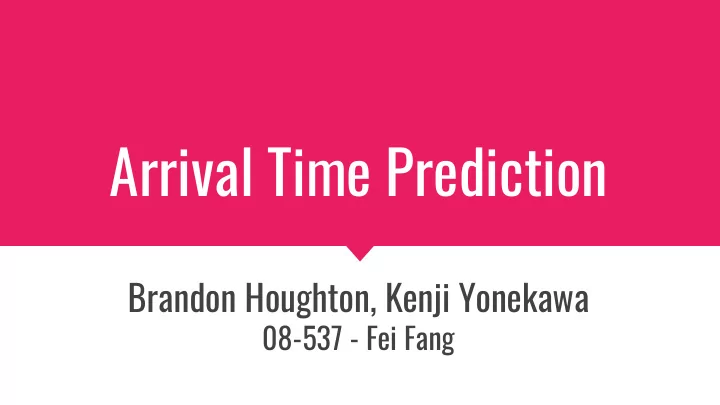

Arrival Time Prediction Brandon Houghton, Kenji Yonekawa 08-537 - Fei Fang
Background The bus should’ve been I’m cold - how much The bus just left.. here 10 minutes ago.. longer should I wait? 2
Motivation High demand for bus arrival prediction ● + 25,000 installs in Pittsburgh alone ○ Consistent daily useage ○ Inefficiency of bus routes ● Lots of available data ● 3
Motivation High demand for bus arrival prediction ● Inefficiency of bus routes ● Higher Utilization drives efficiency ○ Real-Time tracking can inform route changes ○ Delay cited as number one deterrent ○ Missing bus due to inaccurate real time info was number three ○ Lots of available data ● 4
Motivation High demand for bus arrival prediction ● Inefficiency of bus routes ● Lots of available data ● GPS Bus location tracking ○ Passengers track stops within app ○ Real-time traffic estimation ○ Weather, Events, etc. ○ 5
Related Work Multiple studies done ● Y. Bin and Y. Zhongzhen and Y. Baozhen, "Bus Arrival Time Prediction Using Support ○ Vector Machines", 2006 W. Treethidtaphat, W. Pattara-Atikom, and S. Khaimook, "Bus Arrival Time Prediction at ○ Any Distance of Bus Route Using Deep Neural Network Model", 2017 J. Lei, D. Chen, F. Li, Q. Han, S. Chen, L. Zeng, and M. Chen, "A Bus Arrival Time ○ Prediction Method Based on GPS position and Real-time Traffic Flow", 2017 P. Zhou and Y. Zheng and M. Li, "How Long to Wait? Predicting Bus Arrival Time With ○ Mobile Phone Based Participatory Sensing", 2014 Problems ● Often use erroneous location tracking ○ Based on a couple of days of data collection ○ Different setting used (location, time, data) ○ 6
Data Set PAT TrueTime API ● GPS of bus location ○ Updates every 10 seconds ○ Arrival Estimates ○ Weather API ● Precipitation, temperature, wind ○ Updates every hour ○ Stored in GCP 7
Evaluation Limited Horizon ● Riders not interested in accuracy after 15 minutes ○ Buses can change routes ○ Mean Absolute Percentage Error ● Most common ○ Easy to compare ○ 8
Evaluation Previous approaches don’t generalize well ● Pittsburgh is much more diverse ● MAPE: 36.9% MAPE: 12% Wall et. al. 9
Use Velocity Instead of Time Errors do not accumulate ● Velocity ● 10
Qualitative Results Linear Model ● Highly dependent on number of bins ○ Tree Based Model ● Does not generalize well to new month of data ○ Mixture Models ● Feature selection was overfitting validation set ○ 11
PAT Model Speed 12
Model Refinement - Tree Segmentation Speed 13
Model Refinement - Linear Interpolation Speed 14
Model Refinement - External Observations Weekday Weekend Speed 15
Model Refinement - Momentum Model Weekday Weekend Speed 16
Model Refinement - Meta Model Speed .2 x 8:12am .6 x 8:42am .8 x 8:24am .4 x 8:49am 17
Evaluation Setup Results on one Route (61C) that had the most data. ● Train data: March 2018: 155,398 data points ● Test Data: April 2018: 101,504 data points ● True label: future data acquired from PAT’s API ● 18
Evaluation Results # Model name Mean Absolute Percentage Error (MAPE) PAT’s prediction model 1 Linear model 28.48% 2 Piecewise linear model 23.84% 3 Decision tree linear model 22.70% 4 Piecewise linear mixture model 18.53% 5 Decision tree with linear mixture model 15.60% 6 Piecewise linear model with momentum 12.25% Largely affected by historic data. (slope, intercept becomes negative) Haven’t figured out optimal prediction model 19
Future Work Add other data to aid prediction ● Traffic data from Google’s Real Time Traffic ○ Class schedule for local colleges ○ Holidays and Events ○ Provide our contribution as an API or incorporate with ● smartphone applications Allow applications to integrate improved data without changing apps ○ 20
Summary We tackled the societal challenge of predicting bus ● arrival time Evaluated existing research approaches ● Benchmarked existing API ● Developed and evaluated new approach ● New approach outperforms existing API ● 21
Thanks for listening! 22
Reference Photo Credits: https://www.nextpittsburgh.com/city-design/port-authority-rolls-out-real-time-bus-tracking/ Y. Bin and Y. Zhongzhen and Y. Baozhen, "Bus Arrival Time Prediction Using Support Vector Machines", 2006 W. Treethidtaphat, W. Pattara-Atikom, and S. Khaimook, "Bus Arrival Time Prediction at Any Distance of Bus Route Using Deep Neural Network Model", 2017 J. Lei, D. Chen, F. Li, Q. Han, S. Chen, L. Zeng, and M. Chen, "A Bus Arrival Time Prediction Method Based on GPS position and Real-time Traffic Flow", 2017 P. Zhou and Y. Zheng and M. Li, "How Long to Wait? Predicting Bus Arrival Time With Mobile Phone Based Participatory Sensing", 2014 Z. Wall, D. J. Dailey, “An Algorithm for Predicting the Arrival Time of Mass Transit Vehicles Using Automatic Vehicle Location Data”, Transportation Research Board 78th Annual Meeting January 10-14, 23 1999
Recommend
More recommend